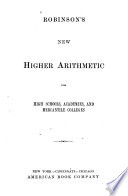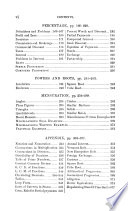 | William Frothingham Bradbury - Arithmetic - 1895 - 200 pages
...number by which to divide. The Quotient is the number of times the dividend contains the divisor. If the dividend does not contain the divisor an exact number of times, the part of the dividend which is left is called the Remainder. 56. The sign of division, ч-, indicates... | |
 | Horatio Nelson Robinson - Arithmetic - 1895 - 526 pages
...number is 1 divided by the number. Thus, the reciprocal of 15 is 1 -a- 15, or ^. NOTES. — 1. "When the dividend does not contain the divisor an exact number of times, the part of the dividend left is called the Remainder, and thismust be less than the divisor. 2. As the... | |
 | William Frothingham Bradbury - Arithmetic - 1895 - 398 pages
...number by which to divide. The Quotient is the number of times the dividend contains the divisor. If the dividend does not contain the divisor an exact number of times, the part of the dividend which is left is called the Remainder. 68. The sign of division, -f- , indicates... | |
 | Floyd Davis - Mining engineering - 1900 - 148 pages
...divisor is the number to divide by. The quotient is the result obtained by the process of division. When the dividend does not contain the divisor an exact number of times, the part of the dividend left is called the remainder, and is always less than the divisor. Q. 9. What... | |
 | William Estabrook Chancellor - Arithmetic - 1901 - 146 pages
...division is called the Quotient. It shows how many times the divisor is contained in the dividend. When the dividend does not contain the divisor an exact number of times, the part of the dividend left undivided is called the Remainder. It is always less than the divisor. The... | |
 | William Estabrook Chancellor - Arithmetic - 1901 - 154 pages
...division is called the quotient. It shows how many times the divisor is contained in the dividend. When the dividend does not contain the divisor an exact number of times, the part of the dividend left undivided is called the remainder, which is always less than the divisor.... | |
 | Samuel Wesley Baird - Arithmetic - 1901 - 388 pages
...it. The division of one number by another is indicated in three ways. Thus, 18 + 6; ^; 6)18. 88. When the dividend does not contain the divisor an exact number of times, there remains an undivided part of the dividend called the remainder. Thus, 8 is contained in 17 two... | |
 | Charles Edward White, Bruce Mervellon Watson - Arithmetic - 1901 - 272 pages
...by 672. 1242 Quotient + 552 Remainder. 672 1 835170 Dividend. 672 i fi'^i ..„.. In this example, the dividend does not contain the divisor an exact number of times, hence there is a remainder. This remainder may be written over the divisor as part of the quotient... | |
 | William Estabrook Chancellor - Arithmetic - 1902 - 242 pages
...division is called the Quotient. It shows how many times the divisor is contained in the dividend. When the dividend does not contain the divisor an exact number of times, the part of the dividend left undivided is called the Remainder. It is always less than the divisor. The... | |
 | William Estabrook Chancellor - Arithmetic - 1902 - 264 pages
...division is called the quotient. It shows how many times the divisor is contained in the dividend. When the dividend does not contain the divisor an exact number of times, the part of the dividend left undivided is called the remainder, which is always less than the divisor.... | |
| |